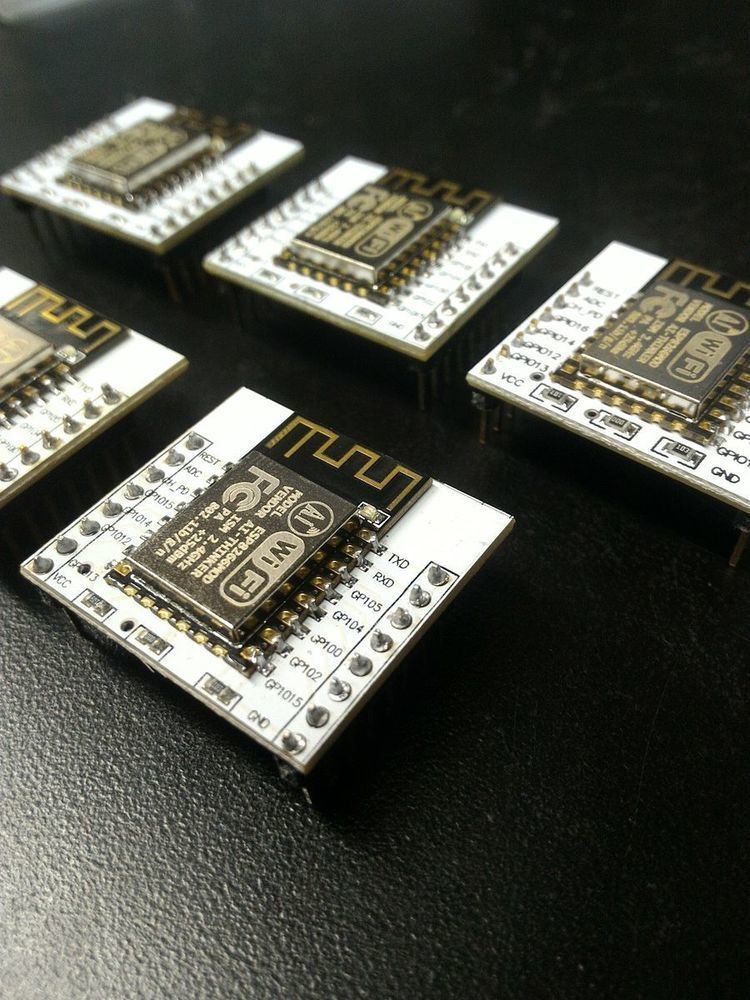Manufacturer Espressif Input 16 GPIO pins | Type Microcontroller Power 3.3 VDC | |
 | ||
CPU @ 80 MHz (default) or 160 MHz Memory 64 KB instruction, 96 KB data | ||
The ESP8266 is a low-cost Wi-Fi chip with full TCP/IP stack and MCU (Micro Controller Unit) capability produced by Shanghai-based Chinese manufacturer, Espressif Systems.
Contents
The chip first came to the attention of western makers in August 2014 with the ESP-01 module, made by a third-party manufacturer, AI-Thinker. This small module allows microcontrollers to connect to a Wi-Fi network and make simple TCP/IP connections using Hayes-style commands. However, at the time there was almost no English-language documentation on the chip and the commands it accepted. The very low price and the fact that there were very few external components on the module which suggests that it could eventually be very inexpensive in volume, attracted many hackers to explore the module, chip, and the software on it, as well as to translate the Chinese documentation.
The ESP8285 is an ESP8266 with 1 MB of built-in flash, allowing for single-chip devices capable of connecting to Wi-Fi.
The successor to these module(s) is ESP32.
Features
* Both the CPU and flash clock speeds can be doubled by overclocking on some devices. CPU can be run at 160 MHz and flash can be sped up from 40 MHz to 80 MHz. Success varies chip to chip.
SDKs
In late October 2014, Espressif released a software development kit (SDK) that allowed the chip to be programmed, removing the need for a separate microcontroller. Since then, there have been many official SDK releases from Espressif; Espressif maintains two versions of the SDK — one that is based on FreeRTOS and the other based on callbacks.
An alternative to Espressif's official SDK is the open source esp-open-sdk that is based on the GCC toolchain. ESP8266 uses the Cadence Tensilica LX106 microcontroller and the GCC toolchain is open-sourced and maintained by Max Filippov. Another alternative is "Unofficial Development Kit" by Mikhail Grigorev.
Other open source SDKs include:
Espressif modules
This is the series of ESP8266-based modules made by Espressif.
In the table above (and the two tables which follow), "Active pins" include the GPIO and ADC pins with which you can attach external devices to the ESP8266 MCU. The "Pitch" is the space between pins on the ESP8266 module, which is important to know if you are going to breadboard the device. The "Form factor" also describes the module packaging as "2 x 9 DIL", meaning two rows of 9 pins arranged "Dual In Line", like the pins of DIP ICs. Many ESP-xx modules include a small on-board LED which can be programmed to blink and thereby indicate activity. There are several antenna options for ESP-xx boards including a trace antenna, an on-board ceramic antenna, and an external connector which allows you to attach an external Wi-Fi antenna. Since Wi-Fi communications generates a lot of RFI (Radio Frequency Interference), governmental bodies like the FCC like shielded electronics to minimize interference with other devices. Some of the ESP-xx modules come housed within a metal box with an FCC seal of approval stamped on it. First and second world markets will likely demand FCC approval and shielded Wi-Fi devices.
AI-Thinker modules
These are the first series of modules made with the ESP8266 by the third-party manufacturer AI-Thinker and remain the most widely available. They are collectively referred to as "ESP-xx modules". To form a workable development system they require additional components, especially a serial TTL-to-USB adapter (sometimes called a USB-to-UART bridge) and an external 3.3 Volt power supply. Novice ESP-8266 developers are encouraged to consider larger ESP8266 Wi-Fi development boards like the NodeMCU which includes the USB-to-UART bridge and a Micro-USB connector coupled with a 3.3 Volt power regulator already built into the board. When project development is complete, you may not need these components and can consider using these cheaper ESP-xx modules as a lower power, smaller footprint option for your production runs.
Other boards
The popularity of many of these "other boards" over the earlier ESP-xx modules is the inclusion of an on-board USB-to-UART bridge (like the Silicon Labs' CP2102 or the WCH CH340G) and a Micro-USB connector coupled with a 3.3 Volt regulator to provide both power to the board and connectivity to the host (software development) computer commonly referred to as the console. With earlier ESP-xx modules, these two items (the USB-to-Serial adaptor and a 3.3 Volt regulator) had to be purchased separately and be wired into the ESP-xx circuit. Modern ESP8266 boards like the NodeMCU boards are a lot less painful and offer more GPIO pins to play with. Most of these "other boards" are based on the ESP-12E module, but new modules are being introduced seemingly every few months.
